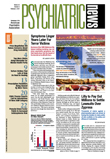It seems logical that as opportunities to engage in legalized gambling have greatly multiplied in recent years, the number of pathological gamblers should have also increased.
A meta-analysis performed by Harvard University researchers supported this hypothesis. When the investigators compared prevalence estimates for pathological gambling derived from mid-1990s studies with prevalence estimates for pathological gambling derived from late-1970s to early-1990s studies, they found significantly higher estimates in the more recent ones (Psychiatric News, March 18, 2005).
Yet a new prospective study out of Canada questions this premise. It found that while gambling increased in a community after a casino opened there, the number of pathological gamblers in the community did not.
The inquiry was conducted by Christian Jacques, a psychology researcher, and Robert Ladouceur, Ph.D., a professor of psychology, at Laval University in Quebec, and the results were published in "A Prospective Study of the Impact of the Opening a Casino on Gambling Behaviors: Two- and Four-Year Follow-ups" in the October 2006 Canadian Journal of Psychiatry. The investigators collected data about the gambling activities of some 800 residents of Hull, Quebec, before a casino was opened and then one, two, and four years afterward. They also collected data about the gambling activities of some 800 residents of Quebec City, where there was no casino in the same time span. Thus, the Hull subjects served as the experimental group, while the Quebec City subjects served as the control group.
The investigators found a significant increase in gambling activities in the experimental group from the year before the casino opened to the year after. However, this trend was not maintained at the two- and four-year follow-up points. Moreover, when the investigators compared gambling activities of the experimental group with that of the control group at two and four years of follow-up, the only significant difference was at the two-year mark—the rate of the experimental group was higher than the control group's.
The scientists then examined the incidence of the number of new probable pathological gamblers for each successive phase of the study. They did not observe any significant differences between the experimental and control groups from pre- to post-test, from post-test to two-year follow-up, or from two-year follow-up to four-year follow-up. They obtained similar results when they examined the incidence of the number of new at-risk gamblers.
Thus, one of their hypotheses—that the arrival of a casino in a community would increase gambling there—was confirmed, Jacques and Ladouceur concluded in their study report. However, two other hypotheses—that the surge in gambling after the casino was opened would endure over time, and that the arrival of the casino would increase the number of pathological gamblers—were not confirmed. In fact, “The trend of the data is in the opposite direction of the hypothesis,” they wrote.
To explain their findings, Jacques and Ladouceur suggested that when a casino or other new gambling venue is built in a community, people in the area are attracted by its novelty, but then lose interest as time goes by. The same may apply to people with gambling problems. Thus, the widely held belief that legalized gambling promotes pathological gambling may be incorrect, or at least the factors behind this assumption may be more complex than originally thought.
The inquiry was funded by Loto-Quebec and by Quebec's Department of Health and Social Services.
